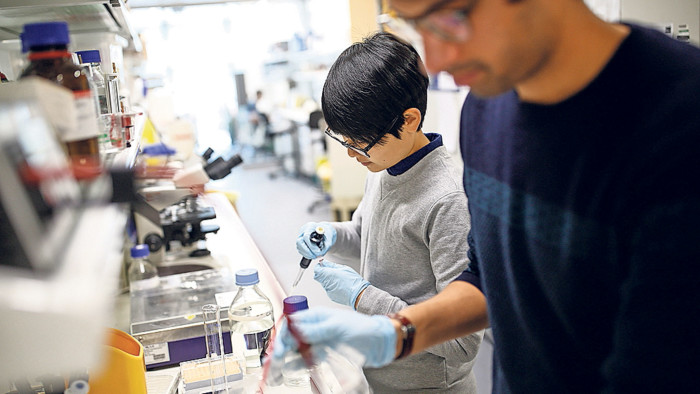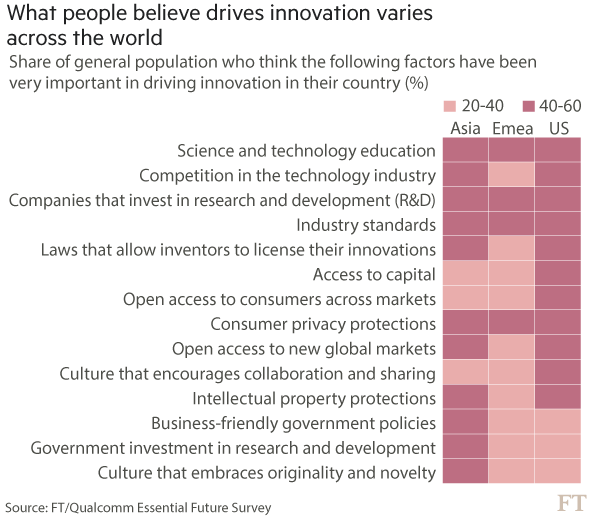UK steps in to plug science funding gap

Roula Khalaf, Editor of the FT, selects her favourite stories in this weekly newsletter.
A low-key pledge made at last October’s Conservative party conference caught the attention of the UK’s science and technology research community — despite being almost drowned out by the sound and fury over about the UK’s decision to leave the EU.
Philip Hammond, the chancellor, announced that British government would take an active role in supporting research and development, a departure from the stance taken by his more laissez-faire predecessors.
In November’s Autumn Statement, Mr Hammond provided more detail: a new National Productivity Investment Fund will inject £4.7bn extra into R&D between 2017 and 2021. It is the largest increase in R&D investment since the Labour government of the late 1970s. The UK government is no longer the outlier among European nations in keeping its market interventions minimal and its regulations as light touch as possible.
The government has also included this investment in its broader industrial strategy, which is being designed to help businesses cope after Britain’s departure from the EU.
The change is a positive step after years of real-terms reductions in government R&D spending, says Professor Sir Keith Burnett, vice-chancellor of Sheffield university and president of the UK Science Council. He wants the government to articulate an even stronger sense of “national purpose” for research, otherwise “you’re never going to get citizens wanting to pay for it”.
The importance of governments in driving a nation’s scientific and technological achievements were outlined most clearly in the 2013 book The Entrepreneurial State by Mariana Mazzucato of Sussex university. In it, Prof Mazzucato traced the role the US government had played in creating Apple’s iPhone.

Without undermining the creative genius of Steve Jobs or the supply chain mastery of his successor Tim Cook, Prof Mazzucato found that almost every piece of technology in the ubiquitous smartphone had its origin in a government programme, dispelling the myth that the success of Silicon Valley was largely the work of eccentric entrepreneurs tinkering in their garages and savvy investments made by venture capitalists.
Apple’s voice-activated personal assistant software Siri, the microprocessor and the micro hard-drive all had their origins in research by the Defense Advanced Research Projects Agency (Darpa), run by the Department of Defense; the multi-touch screen was developed by the CIA and Darpa; GPS, found on most smartphones, was a technology originally created by Darpa and the US Navy. It was the patient investment of government that made today’s digital revolution reality. Prof Mazzucato says: “In almost every sector from IT to biotech, nano tech and clean tech, it has been the US government that has led the way investing in key areas across the innovation chain.”
The UK has had its own science successes over the decades — from the discovery of the double-helix structure of DNA to genetic fingerprinting and to the sophisticated lasers that made CDs and DVDs play.
But when it comes to government funding, the UK lags behind peers almost everywhere. Government spending on research and development in the UK has been on a downward trend, falling from 0.56 per cent of GDP in 2009 to 0.49 per cent of GDP in 2013, according to figures compiled by the Campaign for Science & Engineering (Case). The average in OECD countries in 2012 was 0.7 per cent of GDP, while the EU average was 0.64 per cent.
Mr Hammond’s promise to increase funding was welcomed by the scientific community. However, Naomi Weir, deputy director of Case, says that many questions remain about access to EU programmes and networks after Brexit and the extra cash “takes us about a quarter of the way” towards the 3 per cent of GDP Case believes the government should be devoting to R&D.
Jonathan Haskel, a professor of economics at Imperial College Business School in London, says UK science has been “pretty cheap”, and has resulted not only in taking research out of the lab and into the market, but in lifting overall productivity in the private sector.
Despite some fears in the business world that such public investments might “crowd out” private ones, Prof Haskel says that the opposite tends to happen, with public money attracting further investment from companies.
One place where the government and academia work closely with the private sector is at Sheffield university’s Advanced Manufacturing Research Centre, where Boeing, Rolls-Royce and other companies have clustered to develop sophisticated materials and manufacturing processes.
It is one of seven such centres in the UK which, Sheffield university’s Sir Keith says, “create an intimate relationship” between government and business.
At the same time, Sir Keith says that another form of state-driven strategic investment has been lost, as the sale of state-owned businesses — such as airports and the nuclear industry — has made co-ordinated national R&D investments more difficult. “We have broken up our strategic resources so it is tricky to build back a strategic plan.”
Comments